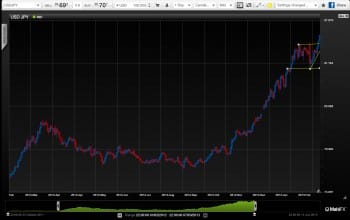By Justin Pugsley, Markets Analyst at MahiFX
Masaaki Shirakawa chaired his last monetary policy meeting this week as governor of the Bank of Japan, but even before his departure tolerance of a strong JPY was already killed off by the new government. What follows now could be the next big leg down in the JPY exchange rate.
Haruhiko Kuroda, widely expected to be the new governor, uttered that now very familiar sentiment expressed by central bankers of doing “whatever” we can do to end deflation in Japan. He complained that the BoJ had failed to do enough monetary stimulus, suggested it could target longer-dated government bonds, start its aggressive monetary stimulus sooner than next year and should try to raise inflation to 2% within two years.
Next month Kuroda will have an opportunity to demonstrate his radicalism and may well start open ended asset purchases by the BoJ within months rather than next year. Such a commitment is likely to see JPY quickly crash through the USD/JPY 100 level mooted as a target exchange rate level by Japan’s authorities. Depending on the tolerance of other major central banks towards the BoJ’s policies, JPY could even reach USD/JPY 110-115 by the end of the year if not much sooner.
USD already breaking out against JPY [See attached chart]
The oddball of central banking
Shirakawa was considered as something of an oddity in central banking and financial circles and was out of tune with the more proactive approach epitomised by US Federal Reserve chairman Ben Bernanke of creating vast amounts of new money to counter deflation, to restart economic growth and to fight unemployment. However, on reflection Shirakawa’s arguments for pursuing a less aggressive monetary policy are rooted in some quite sound arguments. The way he saw it Japan’s major problem was its ageing population. It’s not a particularly exciting argument, but it is a compelling one that deserves some consideration.
Nearly a quarter of Japan’s 128 million population is over the age of 65 and by 2060 that is forecast to rise to 40% with the population shrinking to 87 million people. Simple logic dictates that with household consumption comprising 60% of the economy, there is bound to be less growth and even deflation as the BoJ has often noted in its own research. People who are over 65 tend to spend less and their consumption patterns change.
Interestingly, Shirakawa also warned that the West now faces the same demographic time bomb that went off in Japan around two decades ago. Unfortunately, currency debasement is unlikely to turn the clock back on the consumption patterns of older people, something Shirakawa appeared to understand better than the rest of the central banking community.
The effects of demographic decline cannot be sustainably reversed by quantitative easing and infrastructure projects. A more sinister interpretation for the enthusiasm for aggressive QE is to erode high debt levels through inflation as sustained economic growth is not happening.
Until the next devaluation
If JPY resumes its rapid decline it is bound to stoke more tensions with Japan’s trading partners and rhetoric over currency wars. But in the short-term devaluation does reap rewards. US exports have been helped in the past by a weaker USD. Even in the UK with its ballooning current account deficit, a weaker GBP has helped exports grow outside Europe. The problem is its oversized financial sector – a sunset industry – and over-reliance on Europe.
Japan is now hoping to get some of that benefit as well, but it is likely to be temporary until another major trading country decides to weaken its currency in what is a zero sum game. The USD’s trade weighted index (USD value versus basket of other currencies) has been edging up recently – it’s quite possible that the Fed will seek to halt any long-term rally in the USD and if it does that will undermine the trade benefits gained by other countries from devaluing their currencies. But in the meantime, it sets up some nice trends for momentum and trend traders to take advantage of.
About MahiFX
MahiFX is headed by David Cooney, former global co-head of currency options and e-FX trading at Barclays Capital and responsible for the award winning e-commerce platform BARX and Susan Cooney, former head of e-FX Institutional Sales in Europe for Barclays Capital. Operating as a market maker, MahiFX provides traders direct access to institutional level execution speeds and spreads through its proprietary-built fully automated pricing and risk management technology, lowering the cost of retail forex trading.
Follow MahiFX on twitter at: https://twitter.com/MahiForex and on facebook: https://www.facebook.com/mahifx
Tradersdna is a leading digital and social media platform for traders and investors. Tradersdna offers premiere resources for trading and investing education, digital resources for personal finance, market analysis and free trading guides. More about TradersDNA Features: What Does It Take to Become an Aggressive Trader? | Everything You Need to Know About White Label Trading Software | Advantages of Automated Forex Trading




































